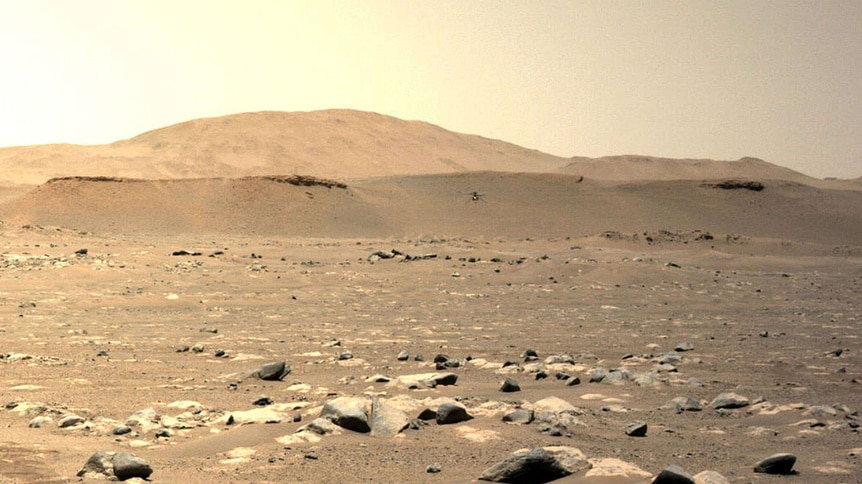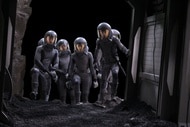Create a free profile to get unlimited access to exclusive videos, sweepstakes, and more!
NASA's Viking Missions May Have Accidentally Killed Martian Life 50 Years Ago
That would be a bummer of astronomical proportions.
In the 1970s, NASA sent two twin missions, Viking I and Viking II, to the Red Planet. Each mission consisted of an orbiter and a lander, allowing astronomers to observe Mars from two vantage points. Viking I touched down on the western slope of Mars’ Chryse Planitia on July 20, 1976. Viking II landed at Utopia Planitia a couple of months later, on September 3, 1976.
They were the United States’ first successful landing missions to Mars and set the stage for decades of successful Martian surface exploration. Notably, the Soviet Mars 3 lander beat the U.S. to the surface of Mars, but failed shortly after landing, having returned only a single unintelligible image. The primary mission for Viking was to gather high-resolution photos from the surface of Mars. The Viking landers achieved that mission big time, sending back the first clear photos from another world.
They weren’t sent to Mars just to be tourists, though. Each lander was also equipped with a set of experimental instruments intended to search for signs of Martian life. A suite of experiments were carried out, two of which showed initial signs consistent with the presence of life. Later experiments showed inconsistent results, leading scientists to conclude that Viking did not detect life. Astrobiologist Dr. Schulze-Makuch has an alternative explanation, suggesting that Viking may have indeed detected microbial life, but the experimental setup killed it in the process.
Did NASA accidentally kill Martian life? Revisiting Viking Mars data with fresh eyes
Over the intervening decades, we’ve learned a lot about how life works on Earth and how it might work elsewhere. We’ve also sent another eight landers to Mars, including NASA’s Curiosity and Perseverance rovers, both of which are currently searching for life in their respective corners of the planet. Notably, we have encountered evidence of organic compounds, something Viking initially detected as well.
Schulze-Makuch suggests the lack of conclusive evidence for life on Mars may have less to do with the planet and any life it’s harboring, and more to do with our own assumptions. Because Earth has so much water, and because it is so crucial for life here, we assume that must be the case elsewhere.
With that in mind, the Viking experiments hydrated Martian regolith (Mars dirt) while checking for life. The idea was that if there was any life there, perhaps in a suspended state, adding water might make it more apparent. It’s a reasonable strategy and one that is effective on Earth for a number of small organisms that haunt extreme, dry environments.
By contrast, there are organisms on Earth who live in water-poor environments and have adapted to thrive there. They’ve cooked up a number of chemical solutions for pulling all the moisture they need out of the air around them, without ever needing direct access to water. Submerging them in water wouldn’t make them more apparent, it would kill them. If we encountered those sorts of microbes on Mars, our experiments would have been less like an interplanetary hello and more like the lethal intentions of Resident Alien's Harry Vanderspeigle or Klaatu from The Day the Earth Stood Still.
Schulze-Makuch likens it to an intelligent alien finding a human stranded in the desert, realizing that we need water, and dumping us in the middle of the ocean. The underlying principle is correct, but it’s too much of a good thing. While Mars very likely used to look a lot like Earth, it hasn’t in quite some time. It’s possible, Schulze-Makuch suggests, that any extant Martian life would have adapted over hundreds of millions of years to tolerate the environment of Mars as it is. Drowning them in water could explain the contradictory results from Viking.
We’ll probably never know if Viking really did detect life. It would be unusual for us to have found it on our first Martian outing, and not in any of our subsequent trips, so it seems unlikely that Viking did find (and kill) miniature Martians. However, it does highlight an important consideration in our search for extraterrestrial life: If we enter into the cosmos carrying Earth-centric biases, we might trip right over life, and maybe even harm it, without even realizing it. And despite what the aliens might think about us, that’s the last thing we want.
A new plan for finding life on Mars
There is no direct analog for Mars on Earth, but our closest terrestrial approximations might be the hyper-arid core of Chile's Atacama Desert or the Dry Valleys of Antarctica.
There, microbes have adapted to live inside salt rocks. They get all the water they need through a process called hygroscopicity, in which salts pull moisture from humidity in the surrounding air. If those microbes are exposed to much more water, they die. In fact, flooding of the Atacama Desert has resulted in the extinction of at least three quarters of the microbial species previously found there.
RELATED: Where did the waters of Mars go? Underground. Maybe Martian life did, too.
When scientists sent Viking to Mars, they designed experiments which would be good at detecting life on Earth. They provided soil samples with water and nutrients, then looked for signs of growth, metabolism, or reproduction. It was a good plan, but potentially ill-informed. Any microbial life on Mars likely looks and behaves more like those Atacama Desert extremophiles than the sorts of microbes you'll find in your backyard.
If life exists on Mars, it might only persist in small pockets where salt rocks and relatively high humidity create favorable conditions. In a recent commentary published to Nature Astronomy Schulze-Makuch suggests that "rather than ‘follow the water,’ which has long been NASA’s strategy in searching for life on the Red Planet, we should in addition follow hydrated and hygroscopic compounds — salts — as a way to locate microbial life."
Catch The Day the Earth Stood Still and the complete first and second seasons of Resident Alien, streaming now on Peacock!
Originally published Sep 1, 2023.
































